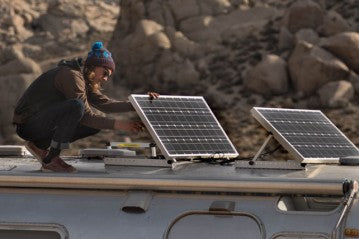
As more and more people embrace the freedom and adventure of RV living, the demand for sustainable and off-grid power sources has significantly increased. One of the most popular options is installing solar panels on an RV. Not only does solar power provide an eco-friendly solution, but it also enables RV owners to enjoy the convenience of electricity wherever they go. However, before diving into the world of solar panels, it's essential to consider a few factors and understand the associated costs. In this article, we will explore three key factors to consider when installing solar panels on an RV and provide insights into the cost of RV solar power installation.
Three Factors To Consider When Installing Solar Panels On An RV
Factor 1: The Size of Your RV
The size of your RV plays a crucial role in determining the number and size of solar panels needed. Larger RVs generally require more solar panels to meet their electricity needs. A larger surface area on the roof means more space to install solar panels, allowing for greater power generation capacity. Additionally, larger RVs often have more appliances and electronics, which increases the energy demand. Consider the available roof space on your RV and calculate the number of solar panels required to ensure optimal energy production.
Factor 2: Your RV's Battery Capacity
Another critical factor to consider is your RV's battery capacity. Solar panels generate electricity during the day, which is then stored in batteries for use during the night or on cloudy days. It's essential to have a sufficient battery capacity to store the energy generated by the solar panels. A larger battery capacity allows for more energy storage, ensuring that you have a reliable power source even when the sun isn't shining. Upgrading your RV's battery bank might be necessary to accommodate the additional energy generated by solar panels, but it will improve the overall efficiency and reliability of your system.
Factor 3: The Amount of Electricity Consumed by Your RV Appliances
To determine the size and capacity of the solar panel system required for your RV, it's crucial to assess the amount of electricity consumed by your appliances. Make a list of all the electrical appliances you regularly use in your RV, such as refrigerators, air conditioners, TVs, lighting, and charging devices. Check the power ratings (in watts) of these appliances and estimate the number of hours they are typically used each day. This information will help you calculate the total energy consumption and determine the appropriate solar panel capacity needed to meet your electricity demands.
Cost of RV Solar Power Installation
The cost of installing solar panels on an RV can vary based on several factors, including the quality of components, installation complexity, and additional features. On average, a basic solar panel system for an RV can cost between $1,500 and $5,000. This price range typically includes solar panels, charge controllers, wiring, and mounting hardware.
The quality and efficiency of solar panels can impact the cost. High-quality, monocrystalline solar panels tend to be more expensive but offer better performance and durability. The number of solar panels required and their wattage also influence the overall cost. Keep in mind that a larger solar panel system can generate more electricity but may also require additional expenses for installation and wiring.
Additionally, the cost of installation might vary depending on whether you choose to hire a professional or opt for a DIY approach. Hiring a professional installer ensures proper placement, wiring, and connection to the RV's electrical system. Professional installation fees can range from $500 to $1,500, depending on the complexity of the project and the location.
Conclusion
Installing solar panels on an RV is a sustainable and cost-effective way to power your adventures while reducing your carbon footprint. By considering the size of your RV, its battery capacity, and the electricity consumption of your appliances, you can determine the appropriate solar panel system for your needs. While the upfront costs of RV solar power installation may vary, the long-term benefits of energy independence and environmental friendliness make it a worthwhile investment. So, embark on your journey towards a greener and more self-sufficient RV lifestyle by harnessing the power of the sun with solar panels.

0 Kommentare